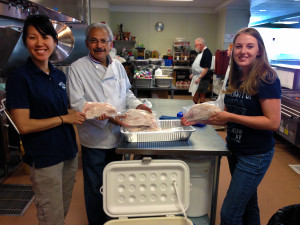Dead Tahoe fish sent to food pantry

St. Vincent’s food pantry benefits from the Tahoe fish kill. Photo/Catholic Charities of Northern Nevada.
With 51,000 pounds of fish harvested in a three-year pilot program to rid Lake Tahoe of invasive fish, scientists are finding a way to put the fish to good use.
This season about 55 pounds of fish fillets went to St. Vincent’s food pantry, which is operated by Catholic Charities of Northern Nevada.
The fish are mainly largemouth bass and bluegill, fish that usually live in warm water. Smaller-bodied fish, not suitable for filleting, are processed and distributed to Animal Ark Wildlife Shelter in Reno. Remaining fish byproduct is transported for composting with local compost processor Full Circle Soils & Compost in Minden.
Most of the fish that have been removed are from the Tahoe Keys in South Lake Tahoe. Crystal Bay and Cave Rock have been other locations where scientists have worked.
The research is conducted in collaboration with UNR and the California Department of Fish and Wildlife.
After fish are temporarily stunned, researchers scoop out the nonnative fish using nets at the end of long poles, while the native fish return to their natural state in a few minutes and swim away.



Global warming, the bass have arrived to bask in the warmer waters of Tahoe. Great sport fishing where natives most likely don’t survive well.
Great use of the non-native species that have been introduced to Lake Tahoe. The removal of these fish benefits native fish, the Food Pantry and the Animal Ark Wildlife Shelter.
Great program to reduce the the number of invasive fish that have been dumped into Tahoe!
Maybe drop some off at Lake Tahoe Wildlife Care. They got some hungry critters out there.
Keep up the good work! Keep these non-native fish out of the lake and either released or given to food pantries. Happy netting, Old Long Skiis
What a great way to fish, throw away the poles and lures, get yourself a shocker !
Glad you all think the project was a success… think again. Removal at the expense of over a million dollars and it didn’t work. And they do not have the money to continue the process and when you kill the bigger fish or predatory fish, the little ones thrive! More small fish or baby fish, now what happens when these fish grow? They become overcrowded in the Keys and their only choice is to push out into the lake. Exactly what they were trying to stop!
If the $1M number is correct, then this is clearly another in a long list of costly failed government agency projects. Cash for Clunkers, Solyndra solar plant, subsidies paid to farmers to not farm, the list is extensive. Meanwhile the bureaucrats are kept busy dreaming up more grants and handing out money. I am watching the fish sneaking back now.
the keys is costing us taxpayers too much. drain and fill.
The Keys is the biggest source of property tax revenue in the city, as well as being a huge source of sales tax and tot. Not to mention the litigation that would ensue if you tried to take people’s private properties away from them. Nobody’s filling in the Keys.
Silly socialists. You can’t operate your government without money from wealthy people.
Around $18K a lb for fresh fish at the soup kitchen, best use of tax dollars. Poor keys owners don’t get hard fighting, large mouth bass sport fishing in the backyard.
Socialists, eg?
Typical straw-dog logical ineptitude.
Move to Texas, you’ll love it and no one wants you here. Win, win.
As usual, prunes, you can’t say I’m wrong, so you just want me to go away and shut up.
People like you can’t stand different opinions from their own.
Guess I should have issued a trigger warning.
For what it’s worth dogula I think we all want you to shut up and go away. Far away.
This is cool and all, but this will do nothing for restoring the native fish population. It’s a man-made Habitat people. Like the milfoil the non-native fish will always be there . The habitat that was created is the problem not the fish. And I say let’s make it a world-class bass fishery. The Keys aint going anywhere people . Leave the non-native fish alone . You are an invasive too. Are we removing you ?